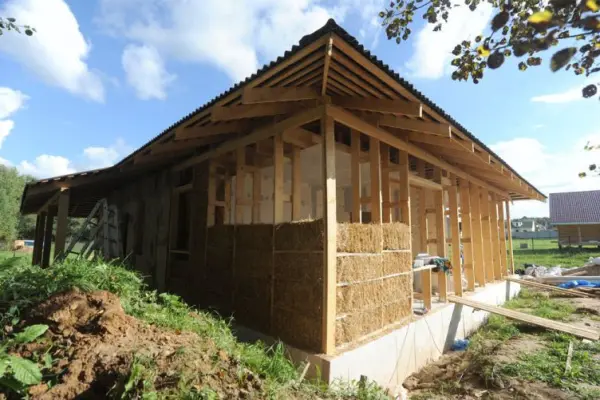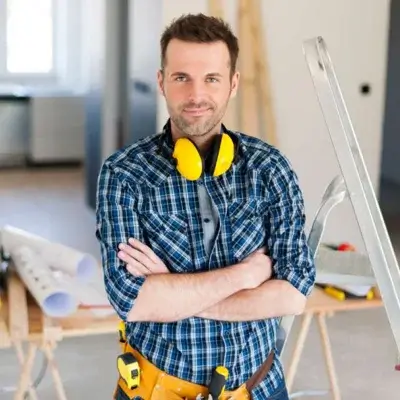Building your own home has always been a dream for many Ukrainians, but high prices for traditional building materials often become an insurmountable obstacle. In 2025, when the average cost of building a conventional brick house is around $500 per square meter, alternative construction technologies are becoming particularly relevant. One such technology — building a house from straw bales — is rapidly gaining popularity due to its cost-effectiveness, environmental friendliness, and excellent thermal insulation properties.
What if you could build a full-fledged, warm, and eco-friendly house for just $3000? Sounds like fantasy? Yet this is exactly how much Ternopil resident Vasyl Fedyshyn spent on his one-story house with an attic and garage, which is approximately one-third the cost of a "bare" one-room apartment in Ukraine.
Straw Bale House Building Technology: A Return to the Roots
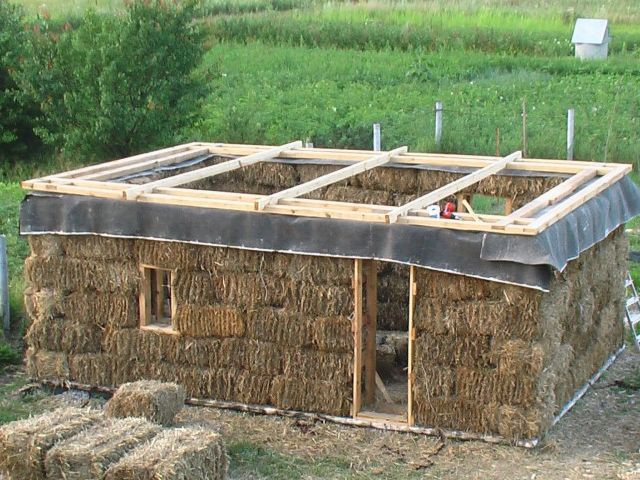 Building houses from straw blocks is not a new invention, but rather a revival of technologies known to humanity for centuries. Incidentally, modern straw house building originates from the late 19th century United States, when the first settlers of Nebraska faced a shortage of construction timber.
Building houses from straw blocks is not a new invention, but rather a revival of technologies known to humanity for centuries. Incidentally, modern straw house building originates from the late 19th century United States, when the first settlers of Nebraska faced a shortage of construction timber.
- The Internet proved to be very useful, - shares Vasyl Fedyshyn. - There I learned about the existence of a special technology - building a frame house from straw bales.
"When I showed the design of my straw house to friends, they just smiled. No one believed that a straw structure could stand for even a couple of years. I won't be disingenuous — I had doubts too. Today my house has been standing for four years already, has excellently withstood several winters with temperatures down to -25°C, and the costs for its heating are 3 times lower than those of neighbors with brick houses of the same area. The most pleasant thing — I built it with my own hands for just $3000 and continue to regularly receive questions from interested people who want to repeat my experience."
The effectiveness of such housing was eventually appreciated by Belarusians. Over almost 10 years, the number of such houses in the neighboring country has significantly increased. There, straw bales are even registered as building materials. According to experts, in addition to cost-effectiveness, a house built using this technology is considered the most environmentally friendly for living.
Advantages of Building a Straw House: Economy and Environmental Friendliness
 In modern construction, attention is increasingly being paid to the environmental friendliness and energy efficiency of materials. Building an eco-house from straw meets both of these criteria while offering significant budget savings. According to the Institute of Environmental Construction, today there are more than 100,000 houses made of straw blocks worldwide, and their number is growing by 15-20% annually.
In modern construction, attention is increasingly being paid to the environmental friendliness and energy efficiency of materials. Building an eco-house from straw meets both of these criteria while offering significant budget savings. According to the Institute of Environmental Construction, today there are more than 100,000 houses made of straw blocks worldwide, and their number is growing by 15-20% annually.
| Characteristic | Straw blocks | Wood | Brick | Aerated concrete |
|---|---|---|---|---|
| Thermal conductivity (W/m*K) | 0.05-0.065 | 0.18-0.23 | 0.56-0.7 | 0.11-0.14 |
| Average cost ($/m²) | 35-50 | 150-200 | 180-250 | 100-150 |
| Environmental friendliness (1-10) | 10 | 9 | 6 | 7 |
| Labor intensity of installation (1-10) | 4 | 6 | 9 | 7 |
| Construction time for 100m² walls | 3-5 days | 7-14 days | 14-21 days | 10-14 days |
The table clearly demonstrates that straw blocks surpass traditional building materials in key indicators, especially in thermal conductivity and cost. This makes them an ideal choice for economical and energy-efficient construction.
The main advantages of building a house from straw bales include:
- Cost-effectiveness – the cost of a plastered straw house with European comfort level is at least half that of a brick one.
- High thermal insulation – straw has thermal conductivity 4 times lower than wood and 8 times lower than brick. Not surprisingly, in the past season, owners of straw houses in the Kyiv region noted a reduction in heating costs of up to 70%!
- Environmental friendliness – straw is a renewable resource, houses made from it create an optimal temperature and humidity regime for health.
- Speed of construction – four people can build the house frame in 2-3 days, and the entire house can be built in 2-4 months.
- Durability – properly built straw houses can last up to 100 years or more, as confirmed by historical examples.
The Ternopil resident built his dwelling for almost a year - he independently created a wooden frame and erected "straw" walls. As the house owner recounts, it cost half as much as a brick wall would have cost, and additionally, the house is immediately insulated thanks to the use of this technology.
Expert Opinion: Straw Houses in Modern Construction
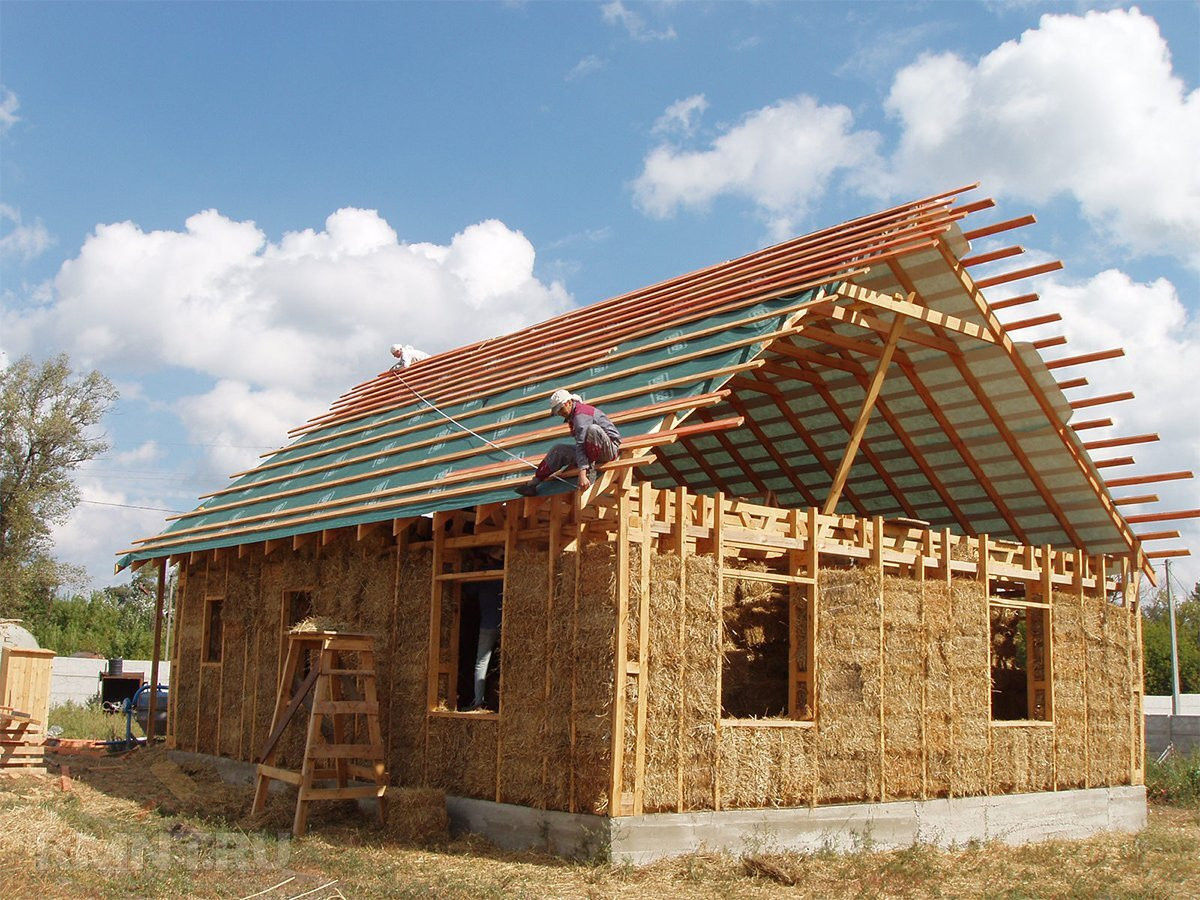 The head of the construction project "EcoHouse" Taras Goncharenko, who has experience in erecting several experimental buildings from alternative materials, notes: "In recent years, we have observed some growth in interest in natural materials. People are more concerned about health and are looking for budget-friendly construction options."
The head of the construction project "EcoHouse" Taras Goncharenko, who has experience in erecting several experimental buildings from alternative materials, notes: "In recent years, we have observed some growth in interest in natural materials. People are more concerned about health and are looking for budget-friendly construction options."
"Straw houses are a solution not only for residential construction. Our experience shows that the technology is excellent for outbuildings, workshops, and even small offices. In the Ivano-Frankivsk region, we built several outbuildings using this technology, and owners note that animals in such buildings feel more comfortable in winter thanks to excellent thermal insulation, and in summer, a pleasant coolness is maintained inside."
According to the latest data from the Association of Environmental Construction of Ukraine, straw houses are more favorable for living than wooden ones, as confirmed by numerous studies. This is due to the naturalness of materials and their ability to "breathe," creating a healthy microclimate.
Experts in the field of eco-construction are unanimous that straw houses are a fantastically effective solution for the climatic conditions of Ukraine. Walls made of dry processed grass have a special structure that creates an extraordinary climate indoors. They absorb the positive energy of nature like a sponge and transmit it to the house's residents.
Practical Guide: How to Build a Frame House from Straw Bales
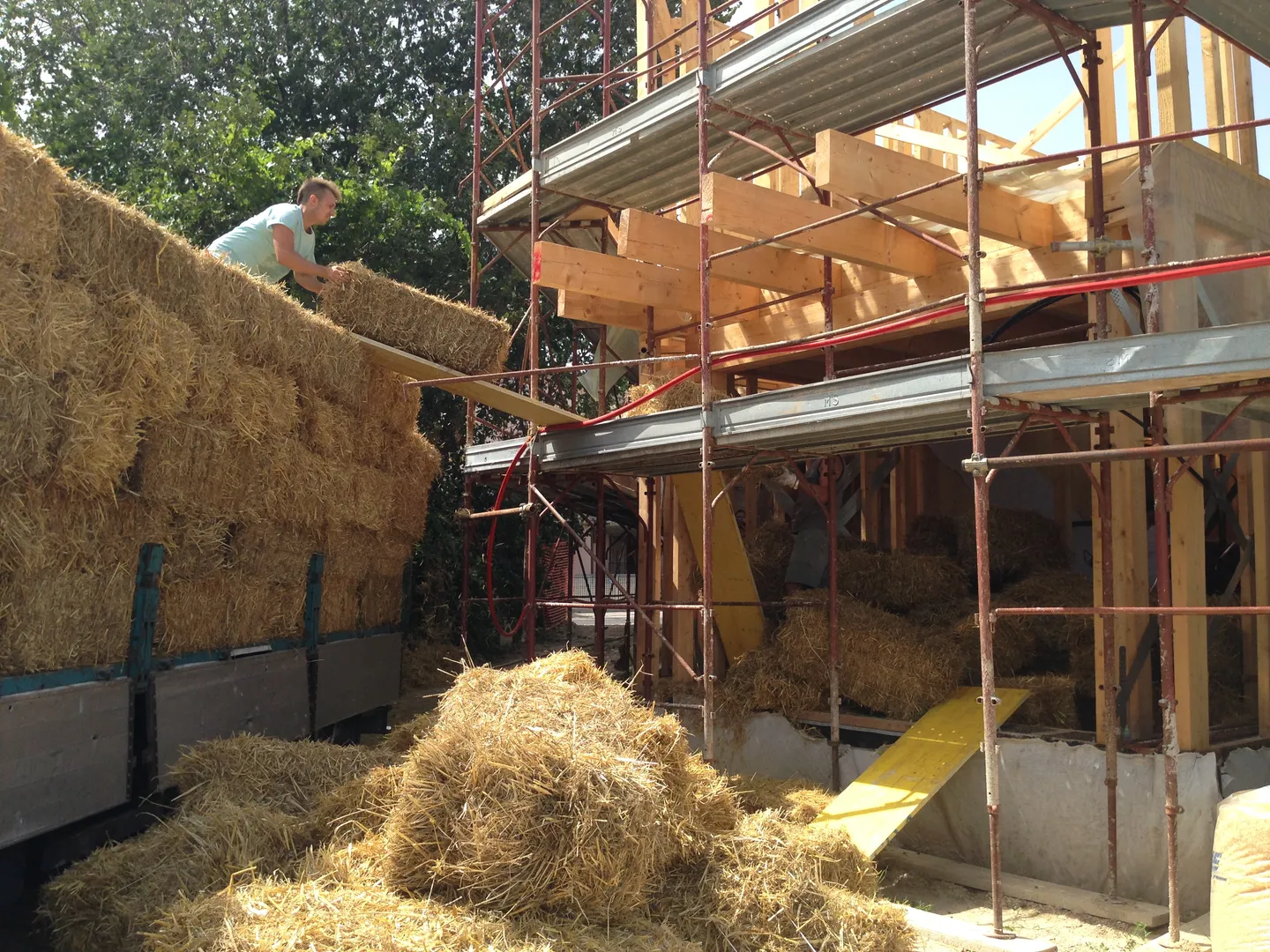 Of course, building a house usually requires an entire crew. However, in the case of straw house building, many owners prefer to build independently, involving friends and relatives, which further reduces costs.
Of course, building a house usually requires an entire crew. However, in the case of straw house building, many owners prefer to build independently, involving friends and relatives, which further reduces costs.
The main stages of building a frame house from straw bales:
- Site preparation and design – determining the dimensions and configuration of the future house, developing drawings.
- Foundation laying – usually a strip foundation or a pile-screw foundation is used, since straw walls are 7-8 times lighter than brick ones.
- Frame erection – the skeleton of the future house is created from wooden beams.
- Straw block laying – bales are placed between frame elements, fixed with wooden or metal pins.
- Roof arrangement – installation of the truss system and roofing.
- Wall plastering – exterior and interior finishing of straw walls with clay, lime, or cement-sand plaster.
- Interior finishing – installation of floors, ceilings, laying of communications.
Vasyl Fedyshyn is not the only enthusiast of such construction in Ternopil. According to him, to erect a building from foundation to roof, he spent 3000 dollars, however, he will finalize the estimate later.
"Many think that building a house with your own hands is something from the realm of fantasy. But when I saw the technology of building from straw bales, I realized: this is it, the solution to my housing problem! Building such a house resembles assembling a constructor set — each element takes its place, and the result is sturdy and warm. Honestly, the most difficult thing for me was the psychological barrier — deciding to start. Now, looking at my finished house, I feel not only pride but also a desire to share my experience with others. After all, affordable housing is a reality, not a dream."
Conclusion: The Future of Straw House Building in Ukraine
Building houses from straw bales is not just a way to save money but also a contribution to environmental conservation. In Ukraine, as in the rest of the world, interest in environmentally friendly construction technologies is gradually growing, and straw houses can occupy their niche in this trend.
Although Vasyl Fedyshyn's experience still remains quite unique for Ternopil, his example shows that the technology has great potential, especially for rural areas. Experts consider the use of straw technologies promising not only for residential houses but also for the construction of outbuildings, barns, workshops, and even tourist eco-cottages. This practical direction may be especially relevant for farm households where straw is an available by-product.
The experience of Vasyl Fedyshyn and other enthusiasts of straw house building shows that building a quality, warm, and inexpensive house with your own hands is quite feasible. The main thing is desire, persistence, and access to information about proper construction technologies.
In 2025, when prices for traditional building materials continue to rise, and environmental issues are becoming increasingly relevant, straw house building represents a practical solution for those who dream of their own home but are limited in funds.
Perhaps now is the time to reconsider our notions of a "proper" house and pay attention to technologies that were successfully used by our ancestors but were undeservedly forgotten in the era of industrialization.
